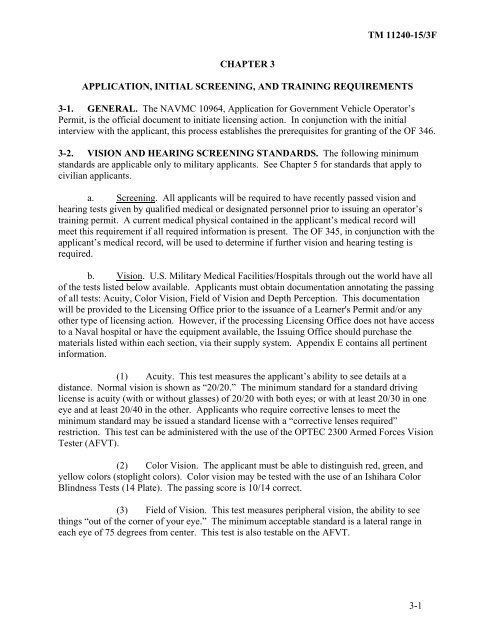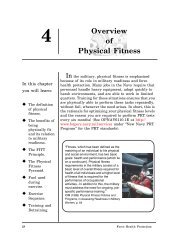TM 11240-15/3F MT Licensing Official Manual - Marine Corps Base ...
TM 11240-15/3F MT Licensing Official Manual - Marine Corps Base ...
TM 11240-15/3F MT Licensing Official Manual - Marine Corps Base ...
You also want an ePaper? Increase the reach of your titles
YUMPU automatically turns print PDFs into web optimized ePapers that Google loves.
CHAPTER 3<br />
<strong>TM</strong> <strong>11240</strong>-<strong>15</strong>/<strong>3F</strong><br />
APPLICATION, INITIAL SCREENING, AND TRAINING REQUIREMENTS<br />
3-1. GENERAL. The NAVMC 10964, Application for Government Vehicle Operator’s<br />
Permit, is the official document to initiate licensing action. In conjunction with the initial<br />
interview with the applicant, this process establishes the prerequisites for granting of the OF 346.<br />
3-2. VISION AND HEARING SCREENING STANDARDS. The following minimum<br />
standards are applicable only to military applicants. See Chapter 5 for standards that apply to<br />
civilian applicants.<br />
a. Screening. All applicants will be required to have recently passed vision and<br />
hearing tests given by qualified medical or designated personnel prior to issuing an operator’s<br />
training permit. A current medical physical contained in the applicant’s medical record will<br />
meet this requirement if all required information is present. The OF 345, in conjunction with the<br />
applicant’s medical record, will be used to determine if further vision and hearing testing is<br />
required.<br />
b. Vision. U.S. Military Medical Facilities/Hospitals through out the world have all<br />
of the tests listed below available. Applicants must obtain documentation annotating the passing<br />
of all tests: Acuity, Color Vision, Field of Vision and Depth Perception. This documentation<br />
will be provided to the <strong>Licensing</strong> Office prior to the issuance of a Learner's Permit and/or any<br />
other type of licensing action. However, if the processing <strong>Licensing</strong> Office does not have access<br />
to a Naval hospital or have the equipment available, the Issuing Office should purchase the<br />
materials listed within each section, via their supply system. Appendix E contains all pertinent<br />
information.<br />
(1) Acuity. This test measures the applicant’s ability to see details at a<br />
distance. Normal vision is shown as “20/20.” The minimum standard for a standard driving<br />
license is acuity (with or without glasses) of 20/20 with both eyes; or with at least 20/30 in one<br />
eye and at least 20/40 in the other. Applicants who require corrective lenses to meet the<br />
minimum standard may be issued a standard license with a “corrective lenses required”<br />
restriction. This test can be administered with the use of the OPTEC 2300 Armed Forces Vision<br />
Tester (AFVT).<br />
(2) Color Vision. The applicant must be able to distinguish red, green, and<br />
yellow colors (stoplight colors). Color vision may be tested with the use of an Ishihara Color<br />
Blindness Tests (14 Plate). The passing score is 10/14 correct.<br />
(3) Field of Vision. This test measures peripheral vision, the ability to see<br />
things “out of the corner of your eye.” The minimum acceptable standard is a lateral range in<br />
each eye of 75 degrees from center. This test is also testable on the AFVT.<br />
3-1



